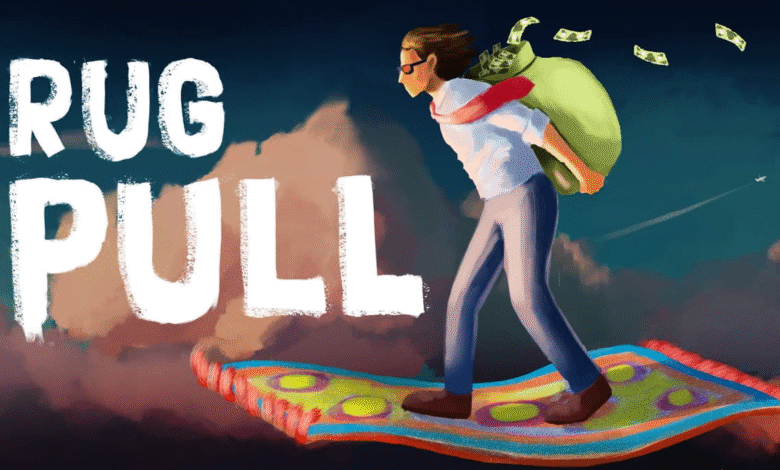How to Spot and Avoid DeFi Rugpulls A Complete Investor Guide

The decentralised finance (DeFi) ecosystem has revolutionised traditional financial services, enabling users to access lending and borrowing. DeFi rugpull detection and trading without intermediaries. However, this innovation comes with significant risks, particularly rug pulls—malicious schemes where developers abandon projects after extracting funds from investors. Top DeFi Insurance, Understanding how to identify these threats is crucial for protecting your cryptocurrency investments in the rapidly evolving DeFi landscape.
What is a rug pull in DeFi?
A rug pull occurs when DeFi project developers suddenly withdraw all funds from a liquidity pool, leaving investors with worthless tokens. This exit scam has become increasingly common, with platforms like Uniswap, PancakeSwap, and SushiSwap witnessing numerous fraudulent projects. The term “rugpull” derives from the phrase “pulling the rug out from under someone,” perfectly describing how investors lose their footing when developers vanish with their money.
Types of DeFi Rugpulls
Hard Rugpulls
Hard rugpulls involve malicious code deliberately programmed into smart contracts. Developers create backdoors or exploitable functions that allow them to drain liquidity pools instantly. These sophisticated attacks often bypass initial security audits and target unsuspecting investors who believe they’re participating in legitimate DeFi protocols.
Soft Rugpulls
Soft rugpulls are more subtle, involving gradual fund extraction through mechanisms like excessive selling pressure, inflated token supplies, or manipulated tokenomics. While technically not theft, these practices devastate token prices and leave investors with significant losses.
Red Flags: Critical Warning Signs of DeFi Rugpulls
Anonymous Development Teams
Legitimate DeFi projects typically feature doxxed developers with verifiable identities, professional backgrounds, and established reputations in the blockchain community. Anonymous teams, while not inherently malicious, present higher risks. Projects like Compound, Aave, and MakerDAO succeeded partly due to their transparent leadership structures.
Key indicators of suspicious anonymity include:
- No LinkedIn profiles or professional backgrounds
- Generic team photos or stock images
- Absence from industry conferences or blockchain events
- Limited social media presence or engagement
Unaudited Smart Contracts
Professional smart contract audits from reputable firms, such as CertiK, ConsenSys Diligence, or Trail of Bits, provide crucial security assessments. Unaudited contracts may contain vulnerabilities or malicious code that enables rug pulls. Always verify audit reports directly on auditing firms’ websites, rather than relying on project-provided documentation.
Liquidity Pool Manipulation
Examine liquidity pool composition and ownership patterns. Warning signs include:
- Single-wallet ownership of the majority of liquidity
- Extremely low liquidity relative to market capitalisation
- Unlocked liquidity that can be withdrawn instantly
- Concentrated token distribution among a few addresses
Unrealistic Tokenomics and APY Promises
Sustainable DeFi projects offer reasonable annual percentage yields (APYs) backed by genuine utility. Rugpull schemes often promise unsustainable returns—sometimes exceeding 1000% APY—without clear mechanisms for generating value. DeFi rugpull detection: Compare promised returns with established protocols, such as Yearn Finance or Convex Finance, to gauge reasonableness.
Technical Due Diligence: Smart Contract Analysis
Code Review and Open Source Verification
Examine the smart contract code on platforms such as Etherscan, BSCScan, or PolygonScan. Legitimate projects maintain open-source repositories on GitHub, accompanied by detailed documentation. Look for:
- Clean, well-commented code
- Regular commits and updates
- Community contributions and discussions
- Formal verification processes
Token Contract Security Features
Analyse token contracts for security mechanisms:
- Timelock functions for major changes
- Multi-signature wallet requirements
- Transparent minting and burning processes
- Proper access controls and permissions
Liquidity Lock Mechanisms
Verify liquidity locking through services like Team Finance, Unicrypt, or DxSale. DeFi rugpull detection, Locked liquidity prevents developers from immediately withdrawing funds, providing investors with an added layer of security. Check lock duration, unlock schedules, and whether locks can be extended or modified.
Community and Social Media Analysis
Organic Community Growth
Genuine DeFi projects cultivate organic communities by creating valuable content, providing regular updates, and fostering meaningful engagement. Rugpull schemes often exhibit:
- Sudden, artificial follower spikes
- Bot-generated comments and interactions
- Lack of genuine community discussions
- Promotional content without educational value
Transparency and Communication
Legitimate projects maintain transparent communication channels, regular development updates, and responsive community management. Red flags include:
- Irregular or absent communication
- Defensive responses to legitimate questions
- Deletion of critical comments or concerns
- Vague or evasive answers about technical aspects
Financial Health Indicators
Trading Volume and Price Patterns
Analyze trading patterns for manipulation signs:
- Artificial volume spikes before major announcements
- Coordinated buying and selling patterns
- Price movements disconnected from broader market trends
- Suspicious wallet activity during critical periods
Market Capitalization Sustainability
Compare market capitalization with actual utility and adoption metrics. Overvalued projects without corresponding user activity or revenue generation may indicate speculative bubbles or manipulation.
Regulatory Compliance and Legal Considerations
Jurisdictional Compliance
Legitimate DeFi projects increasingly prioritize regulatory compliance, implementing know-your-customer (KYC) procedures and anti-money laundering (AML) measures. While decentralization remains important, complete regulatory avoidance may signal questionable intentions.

Legal Entity Structure
Verify whether projects operate through established legal entities with proper registrations. While not mandatory for all DeFi protocols, legitimate projects often incorporate foundations or companies to manage legal responsibilities.
Risk Mitigation Strategies
Diversification and Position Sizing
Never invest more than you can afford to lose in any single DeFi project. Diversify across multiple protocols, blockchain networks, and investment strategies. Consider allocating larger portions to established platforms like Ethereum-based protocols or Binance Smart Chain projects with proven track records.
Gradual Investment Approach
Rather than investing large amounts immediately, consider dollar-cost averaging into promising projects. This strategy reduces exposure to sudden rug pulls while allowing participation in legitimate growth opportunities.
Insurance and Protection Protocols
Explore DeFi insurance options through platforms like Nexus Mutual, Cover Protocol, or InsurAce. DeFi rugpull detection. These services provide coverage against smart contract failures, exchange hacks, and other DeFi-specific risks.
Tools and Resources for Rugpull Detection
Analysis Platforms
- DeFiPulse: Comprehensive DeFi protocol rankings and analytics
- DeFiLlama: Total value locked (TVL) tracking across chains
- CryptoScamDB: Database of known scam projects
- Rug Doctor: Automated rugpull detection tool
- Token Sniffer: Smart contract security analysis
On-Chain Analytics
- Etherscan: Ethereum blockchain explorer and contract verification
- Dune Analytics: Custom blockchain data dashboards
- Nansen: Wallet tracking and transaction analysis
- Chainalysis: Professional blockchain investigation tools
Case Studies: Notable DeFi Rugpulls
AnubisDAO (2021)
The AnubisDAO rug pull resulted in approximately $60 million in losses when developers drained the treasury shortly after launch. This incident highlighted the importance of verifying team credentials and smart contract security before making an investment.
Meerkat Finance (2021)
Meerkat Finance, a Binance Smart Chain yield farming protocol, executed a rugpull worth $31 million by exploiting a vulnerability in their vault contracts. The incident demonstrated how even audited contracts can contain exploitable weaknesses.
Future Trends and Emerging Threats
Sophisticated Attack Vectors
Rugpull schemes continue evolving, incorporating advanced techniques like:
- Cross-chain bridge exploits
- Flash loan attacks
- Governance token manipulation
- Time-delayed malicious code execution
Regulatory Evolution
Increasing regulatory scrutiny may reduce the frequency of rug pulls, but it could also drive malicious actors to more sophisticated evasion techniques. DeFi rugpull detection: Stay informed about regulatory developments in your jurisdiction.
Summary
Identifying rug pulls in DeFi projects requires comprehensive due diligence combining technical analysis, community evaluation, and risk assessment. While the decentralised nature of DeFi provides unprecedented financial opportunities, it also demands heightened vigilance from investors. By understanding warning signs, utilising proper analysis tools, and implementing risk mitigation strategies, you can significantly reduce your exposure to rugpull schemes while participating in the revolutionary DeFi ecosystem.
Stay informed about emerging threats, maintain a diverse portfolio, and remember that thorough research is your best defence against DeFi rug pulls. DeFi rug pull surge, The blockchain community continues developing better security measures and detection tools, but individual investor education remains the most effective protection against malicious schemes.
FAQs
Q1. What is a rug pull in DeFi?
Ans: A rug pull is a scam where developers withdraw all liquidity from a project, leaving investors with worthless tokens and no recourse.
Q2. How can I identify a potential rug pull?
Ans: Watch for anonymous teams, unaudited smart contracts, unrealistic APY promises, and sudden community growth.
Q3. What are the types of rug pulls in DeFi?
Ans: There are hard rug pulls that utilize malicious code, and soft rug pulls that involve deceptive tokenomics or excessive selling.
Q4. How can I protect my investments from DeFi rug pulls?
Ans: Conduct technical due diligence, diversify your investments, and use DeFi insurance services where available.
Q5. Are audited DeFi projects always safe from rug pulls?
Ans: No—some rug pulls have occurred in audited projects, so always verify audits and continuously monitor project behavior.
